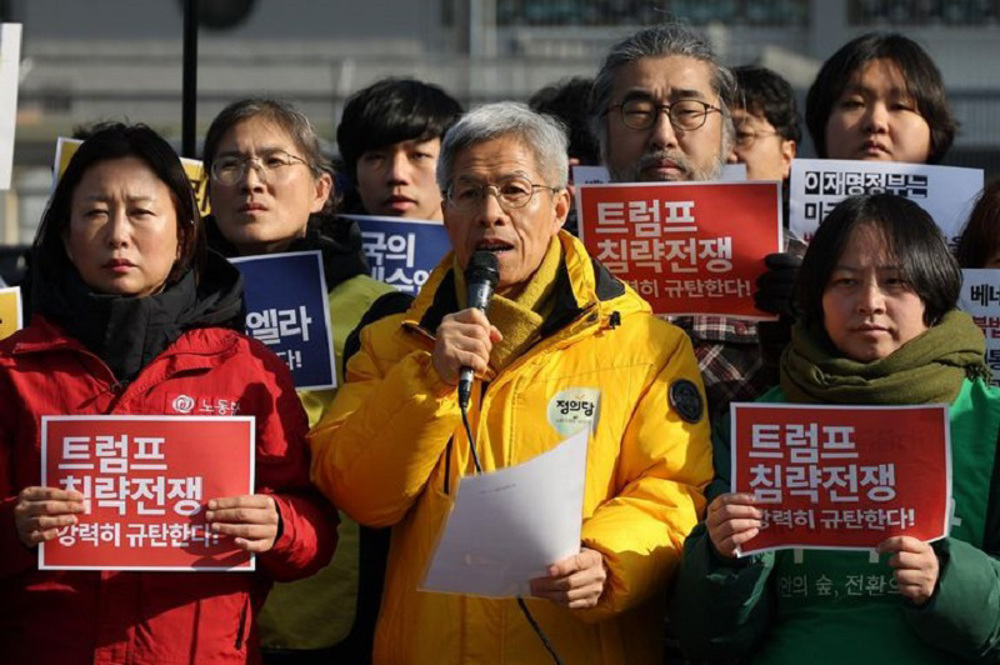Agricultural independence secure despite US maximum pressure
Despite innumerable US, UN and EU sanctions Iran has managed to maintain food security and agricultural independence.
Visit any restaurant in Iran and you will be served unlimited amounts of bread, cheese, yogurt and walnuts with whatever meal you may have ordered.
However, Trump’s Maximum Pressure Policy is still having an adverse effect on food and drug availability.
During the four decades since the Islamic Republic was founded, we have been able to meet 80% of our agricultural needs and food, and we have the least dependence in this regard, especially on products such as wheat, we have managed to become relatively self-sufficient for some years.
In the years when we faced drought, we met at least 80% of our wheat needs from the inside. The same was true for other strategic products. In the field of dairy products, rice, and some other strategic products, we have been able to achieve relative self-sufficiency and even managed to export five to six billion dollars a year in various agricultural products.
Iran, which is so geographically diverse that it exhibits distinct seasons at any given time, is doing well agriculturally. That is in the short term, but longer term planning is essential to the retention, maintenance and improvement of water levels, soil quality, foreign policy and people’s purchasing power.
Disjointed as these factors may sound, they are essential for foodstuffs availability, security and a lucrative food industry.
Any successful food chain begins with production and ends in consumption.
Food security has 4 main pillars. The first pillar of the debate is availability, meaning that food must be available in the required amount. It goes without saying that the agricultural sector needs resources and agricultural components to produce food, perhaps the most important of which are basic resources such as soil, water, our biodiversity, and other factors of production, including the productive components, machinery, and so on.
Ali Kiani Rad, Agricultural Planning and Economic Research Institute
This all depends, of course, on the equitable and timely delivery of agricultural produce to market. So long as profiteering villains are prevented from hoarding, which raises prices artificially, and the populace can afford it, there is plenty to feed the masses and keep Iranian cuisine alive.
According to the FAO Iran, which it ranked ninth in terms of grain reserves, produced of 21.6 million tons of grain during the last crop year.
Achieving this rank while the country is suffering from a drought is commendable. With 17th place in terms of population in the world, Iran is in possession of 1.1 percent of the world's grain reserves.
Fortunately, during the four decades since the Islamic Republic was founded, we have been able to meet 80% of our agricultural needs and food, and we have the least dependence in this regard, especially on products such as wheat, we have managed to become relatively self-sufficient for some years. In the years when we faced drought, we met at least 80% of our wheat needs from the inside. The same was true for other strategic products. In the field of dairy products, rice, and some other strategic products, we have been able to achieve relative self-sufficiency and even managed to export 5 to 6 billion dollars a year in various agricultural products.
Sadegh Khalilian, Former Iranian Minister of Agriculture
Wheat, barley and rice; Iranian diet
The wheat harvest actually decreased by 500,000 tons in the last crop year, however, the rice harvest has increased by 200,000 tons. The production of other grains grew by 200,000 tons. Wheat, barley and rice are the mainstay of the Iranian diet.
Unfortunately, we are over 70% dependent on inputs. This is not called strategic agriculture for a country, when we have to import seeds, when we have to import pesticides and fertilizer to a large extent. We have to import livestock and fish feed inputs. This means incomplete and improper planning in the field of agriculture.
Somayyeh Rafi’e MP, Agricultural Committee
FAO, the United Nations’ Food and Agriculture Organization, has estimated the area under wheat cultivation in Iran will increase slightly in 2020. The area under cultivation is around 6 million hectares.The country comprises 14% arable land, 8% forest, 55% natural (non-arable) pastures and 23% desert.
One of the major projects undertaken in the Islamic Republic was the Agricultural Development Project, which we have been pursuing since 2010. We provided 9-trillion tomans of cheap credits and facilities to farmers, and we also helped new investors to invest in various fields with low-interest facilities.
Sadegh Khalilian, Former Iranian Minister of Agriculture
In March 2020, the Government announced plans to purchase nearly 75 percent of the domestic wheat production with the goal of eliminating reliance on imports for domestic consumption.
With so much talk of domestic consumption, it’s easy to lose sight of the importance of exports.
Although Iranian agricultural products are renowned globally, there is still much room for improvement in the farming and agricultural sector. This can be aided by foreign investment and the further introduction of farming technology and management of water resources.
Export hurdles
As with any sector, exports must move from raw and unpackaged produce to processed material and standardized packaging of organic produce.
Unfortunately, Iran has a very small share in the global agricultural market, which is also a lucrative one. This is because, unfortunately, we have not and still do not have an integrated trade policy system based on the model of a resistive economy. I will mention some of the problems here on a case-by-case basis. One is the problems of the bureaucracy. The second is the lack of coordination between the organs. We don’t have a specific body that is responsible for the export of agricultural products.
Abdolmajid Sheikhi, University Professor, Economist
Foreign investment
The Government had planned to attract 8 billion dollars of foreign investment in the agricultural sector over a period of 4 years. That was before the 2015 JCPOA, or nuclear deal, which would have facilitated just that, by lifting UN-imposed Iran sanctions, in return for Iran limiting its peaceful nuclear programme.
But before the contents of the deal can materialize, the US pulled out and redeployed and reinforced economic nuclear-related UN sanctions, as US sanctions.
Foreign investment in our country has not been very successful. There are several reasons for that, some of which are internal and others external and out of our control. Internal reasons include the problem of bureaucratic processes in the country, which makes it somewhat difficult to invest. I can use the term self-sanctioning to describe it. The issue of foreign sanctions has also had its impacts. More important than sanctions is the issue of investment security and the feeling of investment security. We are the safest country in the Middle East. Some admit this, some do not. But the media propaganda tries to undermine the perception of this security.
Somayyeh Rafi’e MP, Agricultural Committee
Iran's share in international markets is pretty low, in spite of its present resources and future potential, Its share in the global market is at under 5 percent. The FAO asserts threats should be turned around into opportunities, to turn small-scale farming into macro-farming. The infrastructure is already present, given Iran’s varied terrain, with four seasons occurring simultaneously, and a varied influx of produce all the year-round.
We are at the crossroads of the North-South and East-West trade corridors. This crossroads can be a special place for us in exporting products that are cultivated and created through investment in our country. Energy is abundant in this country. We have a lot of renewable energy. In addition to being one of the world's leading oil and gas producers and having huge reserves, we have renewable energy that can be used organically without generating pollution and with the lowest pollution costs to serve production and investment. We also have a large and young workforce.
Abdolmajid Sheikhi, University Professor, Economist
Qanat Irrigated Agricultural Heritage Systems
The Qanat irrigated agricultural systems made Iran the most fertile area in the history of Asia. There was once mass production of grains, as well as sugarcane, and date palm.
Qanats are underground tunnel systems that bring infiltrated groundwater, surface water, or spring water to the earth's surface using only gravitational force. Qanats have been used for irrigation and drinking water for centuries worldwide, particularly in the Middle East and North Africa and Central and West Asia.
Iran's wheat yield reached 14 million tons in 2004, making Iran self sufficient in wheat ending 45 years of wheat imports, saving $1 billion a year in overseas purchases.
Iran may have lost the European market, in spite of the high quality of its exports, however, it is still exporting to countries such as Iraq, Azerbaijan and Afghanistan.
Apart from pistachio and saffron, of which Iran is the world's biggest producer, exports of other agricultural commodities, such as dates, apples, milk and vegetables, are not economically viable for Iranian exporters.
Major agricultural exports
The most notable agricultural exports of Iran include fresh and dried fruits, nuts, animal hide, processed foods, caviar and spices. In terms of value, Pistachio, raisins, dates and saffron are the first four export products.
Aras Fathi, Founder and Manager, Bell Pepper Greenhouse, who set up his enterprise with a view to exports as well as domestic sales says:” From the beginning I looked at the market and I saw in Iran the consumption of this product, I mean bell-peppers, is better and it is also against some kind of cancer. So we need to have it in our foods. We are exporting more than half of our products to Russia and Persian Gulf states. Ten percent is for domestic use and 90 percent for export.”
A danger to both self-sufficiency and exports that bring foreign currency into the country is unfettered imports and exports whereby the most basic needs of the masses become a source of astronomical income to the greedy few, and the balance between imports, exports and domestic produce for domestic use is altered.
Our Ministry of Industry, Mining, and Trade is structured so that it’s more willing to import in this regard. The desire to import is extremely high. The interests of many traders dominating the country's markets and product supply hinder the development of exports. There are some brokers who are mainly looking for imports because that’s how they generate money. Being able to attain licensing for import and export is a public right. It must not be given to a select few. Licenses must be granted to productive cooperatives.
Abdolmajid Sheikhi, University Professor, Economist
The share of the agriculture sector in Iran's non-petroleum gross domestic product (GDP) reached 8.8 percent in the previous Iranian calendar year, which began March 21st, an increase of 3 percent over 7 years.
There’s room for more growth in the agriculture sector however, by using modern science and new technologies and methods, both in the technical aspects and in the commercial sector.
In two ways I think we are going forward, one is academic studies and it helps us to become a farmer. I am not a farmer’s son; I am an agriculture engineer but I decided to make this. The other thing is sanctions because these sanctions motivates or forces us to do everything ourselves.
Aras Fathi, Founder and Manager, Bell Pepper Greenhouse
Now in spite of all the talk of mechanizing or further modernizing farming, the gardening business, one branch of the industry, boasts it has mechanized enough to have produced yield crops at higher quality and lower more competitive costs.
The agricultural sector at large however, must become more demand orientated than supply-orientated, to make better-engineered profit from sales.
This is although Iran claims over 95 percent of the technology and knowledge in this area—mechanization--is domestic.
The agricultural industry falls short of raw material production, be it growing grain and fruit or husbanding cattle and farming fish. Gardening has contributed significantly to non-oil exports and employment. With updated packaging methods it can do yet better.
The ground for attracting foreign investment for agricultural development is provided. Foreigners can make good profits if they invest in fields such as packaging, processing of agricultural products and many other areas. The point is that Iran is a secure country and I think investors should take that into consideration. Iranian government guarantee their original capital and the profit there of.
Sadegh Khalilian, Former Iranian Minister of Agriculture
Now we can toil all we want. But with climate change and population growth, and now a viral pandemic running rampant, planning is essential to continued food security. Crops which provide both sustenance and financial resources, can only be guaranteed by the health of mother earth, her water and soil.
Over the past centuries, due to population growth and the need for food, and not only in Iran but all over the world, we had to take the water out of the ground, build a variety of dams and allocate more for the urban and industrial use and less for the agricultural sector. Failure to control water consumption patterns in the drinking and industrial sector, locating water-demanding industries, such as steel factories, away from parts of Iran like the North and the South where we have huge water resources, and instead, running them in deserts in central Iran have all been policies that have jeopardized the country's water balance and water security.
Ali Kiani Rad, Agricultural Planning and Economic Research Institute
Iran is investing heavily in its youth at knowledge-based companies, in parallel with FAO projects. This is of paramount importance considering major water resources have been desiccated by overuse and excessive deep-well utililization authorized during the previous administration.
We have no choice but to invest in technology and knowledge-based institutions. The sanctions target both our foreign investment and our ability to import the technology we need. The solution is to take steps similar to other countries that have been sanctioned and threatened. They have relied on domestic resources and not on capital and technology coming from abroad.
Ali Kiani Rad, Agricultural Planning and Economic Research Institute
The role of watershed management and water distribution management in achieving improvements in the field of agriculture is significant.
The FAO has implemented a TCP project in Iran to assist the country in rehabilitating the soil and water resources and enhancing the resilience of agriculture system and rural communities against climate change and climatic disasters.
To replenish two important water resources, the regions of Qazvin Plain (Qazvin Irrigation Network) and the Urmia Lake Basin, Water Accounting and mapping Evapotranspiration is a prerequisite.
Water accounting is the process of collecting, analysing, summarizing and reporting water related information. It reveals how water is used across different sectors and helps in understanding the benefits and existing trade-off of the water allocations and use patterns. And the integrated and cross sectional presentation of the information in water accounting helps the users (decision-makers) to see the bigger picture.
It is important to assess and map agro-ecological zones and water availability to develop appropriate crop patterns. The development and implementation of different crop patterns can contribute to the attainment of higher land productivity, increased crop production in other words.
We have several points of view in the agriculture Commission. One is why, for example, the main livestock feed in our country should be corn, which we can’t grow inside Iran? There are plants and fodder that can be grown anywhere without special care in our country, which has a hot and dry climate. We must have an approach toward non-dependency on some inputs. It’s not like we make a decision this year and reap the rewards the next year. But we can make the right decisions for the coming years, which I think will have a positive outcome.
Somayyeh Rafi’e MP, Agricultural Committee
Farmers with academic qualifications
Armed with a degree in Agricultural Engineering, zest and much perseverance, our “farmer” has fully mechanized his plantation.
In lots of aspects they are different. One of them we have seven meters height, and even everything is controlled by the smart climate control system which helps us to use less people to help us and we are doing this kind of things by hand in other greenhouses. But here everything is automatic.
Aras Fathi, Founder and Manager, Bell Pepper Greenhouse
The Food and Agriculture Organization of the United Nations (FAO) is holding an eLearning program in Iran to equip experts with the knowledge and skills to implement REWAS the advanced approach of Real Water Savings (REWAS).
REWAS uses the concept of ‘following the water’, under this concept, drainage, runoff and percolation of groundwater are no longer considered ‘losses,’ because downstream users often use these recoverable waters.
Arab rights group urges UK to sanction Netanyahu over 'incitement to genocide' in Gaza
‘Political, non-constructive’: Iran slams UNHRC special session on recent riots
Forced evacuations in South Gaza as Israeli military expands control over land
Iran reports steep rise in exports after forex policy shift
Iranian bank loans up 47.2% y/y in Apr-Dec
Macron slams Trump’s ‘bullying’ as US threatens tariffs, pushes Greenland grab
Israeli rape victim and former captive says Hamas felt safer than Israel
VIDEO | Press TV's news headlines



















 This makes it easy to access the Press TV website
This makes it easy to access the Press TV website